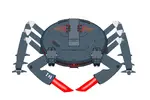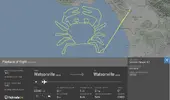Standard crosswind technique Known as the "Crabbed Approach"
Ideally, runways are aligned into the direction of the wind. It makes take off and landing easier since there's no sidewards component of wind to deal with, and safer since it uses less runway....In reality of course, the wind strength and direction are variable, so we have to have well rehearsed methods for crosswind approaches and landings. The technique that most aircraft use when making an approach with a sideways component to the wind (a cross wind) is the crabbed approach. Think of it as trying to swim across a fast flowing river to your mate who is directly opposite you on the far bank....If you aimed straight towards him you would be carried downstream by the flow, and not arrive where you intended. To be able to track directly towards your mate, you would have to aim upstream enough so that the sideways movement from the flowing river is cancelled out. Its basically a triangle of velocities with the resultant vector being in the direction you want.
Aeroplanes are just the same, they have to aim into the wind. If they aimed straight for the runway threshold then they would be blown downwind of the centerline and miss the runway. Relative to a stationary observer on the ground, the aeroplane would be flying through the air diagonally (like a crab), and perhaps to a passenger in sight of the runway out of a side window it may appear the same, however the aeroplane is flying very much straight through the air...its just that the air itself is moving relative to the ground!
The problem with this however is the eventual touchdown. Aeroplanes are designed to land on their main wheels which (for all bar one or two rare military types) are non castoring. They are VERY strong and capable of absorbing massive compressive forces, but what they don't like are side loads. The crabbed approach with it's nose offset orientation would load up those main wheels with side loads if touching down without straightening up first. This is all done at the last second when the aircraft rounds out just above the runway by using enough rudder to align the nose (and wheels) with the runway, and applying opposite roll control to maintain wings level. Very satisfying when done correctly!




